- MANUAL ASSAY PROCEDURE; D-FRUCTOSE AND D-GLUCOSE
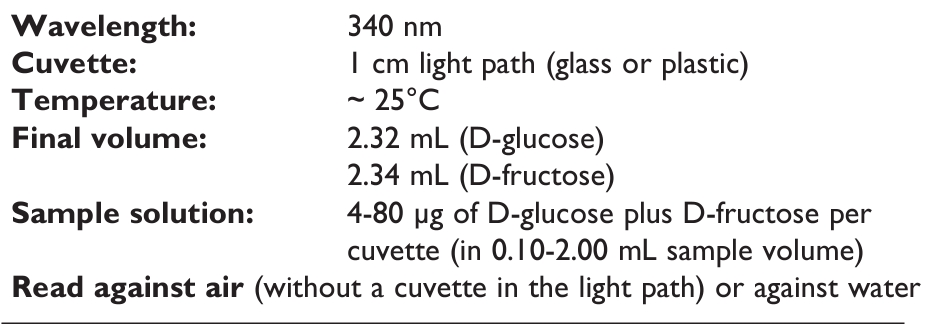
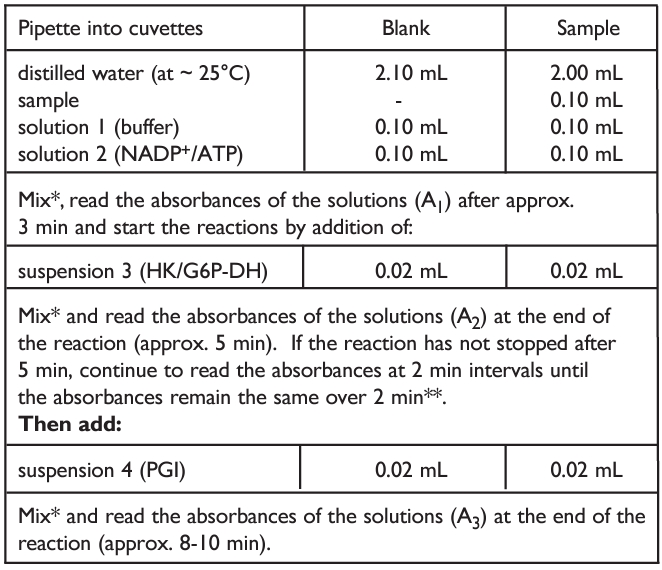

- MANUAL ASSAY PROCEDURE; TOTAL REDUCING SUGARS
In the wine industry the sum of D-glucose plus D-fructose is a key quality parameter, as this represents the amount of sugar that is available to the yeast for conversion into ethanol. In the vast majority of cases it is unnecessary to differentiate between these monosaccharides, allowing them to be quantified together using a more convenient and rapid assay format, as follows:
Additional preparation step:
Gently shake bottles 3 and 4 to remove any enzyme that may have settled on the rubber stoppers. Using a pipette, transfer the entire contents of bottle 4 (PGI) into bottle 3 (HK/G6P-DH). After replacing the rubber stopper, mix the enzymes by gentle swirling. This HK/ G6P-DH/PGI mixture is now ready for use. After performing this step, D-glucose and D-fructose cannot be measured individually with this kit reagent mixture.
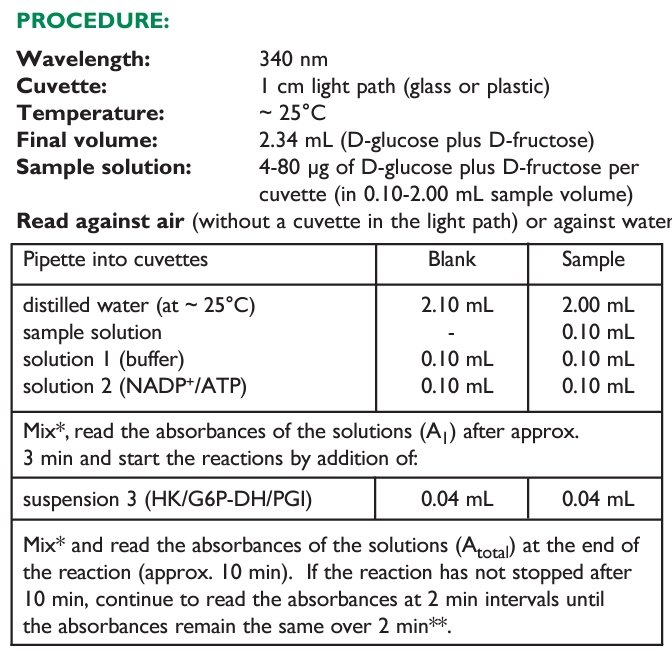
- AUTO-ANALYSER ASSAY PROCEDURE; TOTAL REDUCING SUGARS
This kit is suitable for the preparation of 254.1 mL of reagent
(equivalent to 1155 reactions of 0.222 mL).
Reagent preparation is performed as follows:
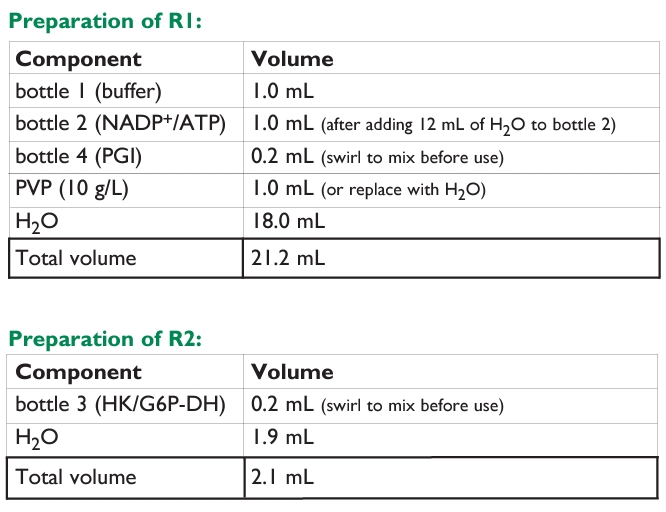

- MICROPLATE ASSAY PROCEDURE; RESIDUAL SUGARS
NOTES:
1. The Microplate Assay Procedure for D-glucose/D-fructose can be performed using either a single point standard or a full calibration curve. 2. For each batch of samples that is applied to the determination of D-glucose/D-fructose either a single point standard or a calibration curve must be performed concurrently using the same batch of reagents.
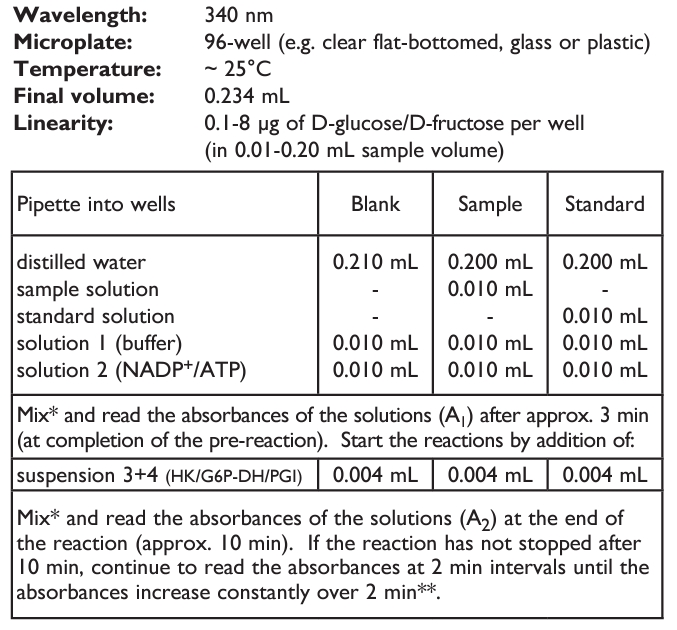

- MICROPLATE ASSAY PROCEDURE; D-GLUCOSE AND D-FRUCTOSE (Sequential)
NOTE: The Microplate Assay Procedure for sequential determination of D-glucose/D-fructose can only be performed using a microplate reader with the capability of converting absorbance values to a 1 cm pathlength.
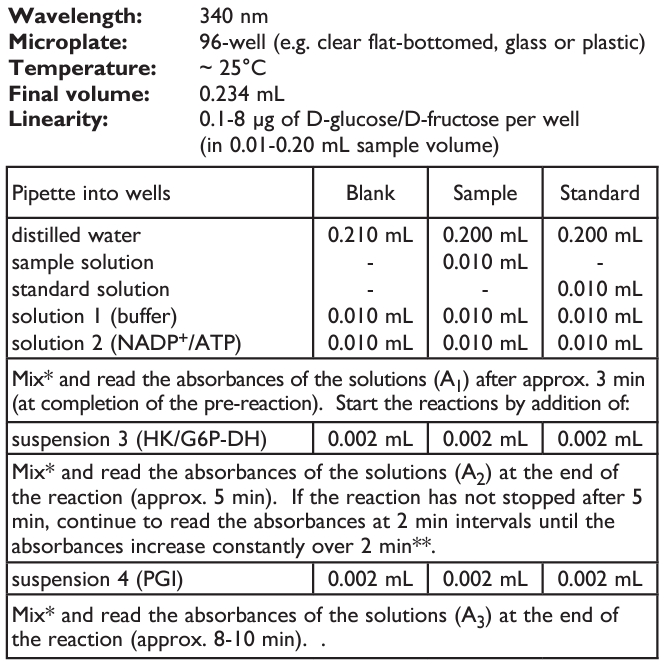

- SAMPLE PREPARATION (Manual Formats A and B)
1. Sample dilution.
The amount of sugar (D-glucose plus D-fructose) present in the cuvette (i.e. in the 0.1 mL of sample being analysed) should range between 4 and 80 μg. The sample solution must therefore be diluted sufficiently to yield a sugar concentration between 0.04 and 0.8 g/L.
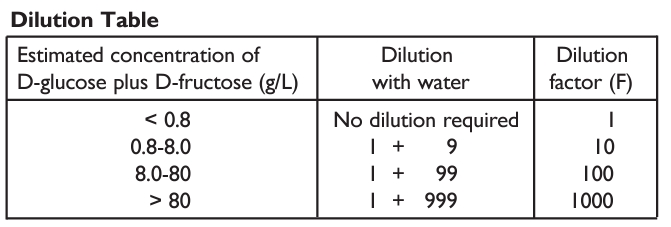
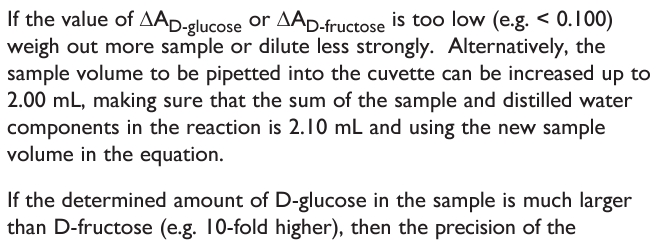

2. Sample clarification
a. Solutions:
Carrez I solution. Dissolve 3.60 g of potassium hexacyanoferrate (II) {K4[Fe(CN)6].3H2O} (Sigma cat. no. P9387) in 100 mL of distilled water. Store at room temperature.
Carrez II solution. Dissolve 7.20 g of zinc sulphate (ZnSO4.7H2O) (Sigma cat. no. Z4750) in 100 mL of distilled water. Store at room temperature.
Sodium hydroxide (NaOH, 100 mM). Dissolve 4 g of NaOH in 1 L of distilled water. Store at room temperature.
b. Procedure:
Pipette the liquid sample into a 100 mL volumetric flask which contains approx. 60 mL of distilled water, or weigh sufficient quantity of the sample into a 100 mL volumetric flask and add 60 mL of distilled water. Carefully add 5 mL of Carrez I solution, 5 mL of Carrez II solution and 10 mL of NaOH solution (100 mM). Mix after each addition. Fill the volumetric flask to the mark, mix and filter.
3. General considerations
(a) Liquid samples: clear, slightly coloured and approximately neutral, liquid samples can be used directly in the assay.
(b) Acidic samples: if > 0.1 mL of an acidic sample is to be used undiluted (such as wine or fruit juice), the pH of the solution should be increased to approx. 7.6 using 2 M NaOH, and the solution incubated at room temperature for 30 min.
(c) Carbon dioxide: samples containing a significant amount of carbon dioxide, such as beer, should be degassed by increasing the pH to approx. 7.6 with 2 M NaOH and gentle stirring, or by stirring with a glass rod.
(d) Coloured samples: an additional sample blank, i.e. sample with no HK/G6P-DH, may be necessary in the case of coloured samples.
(e) Strongly coloured samples: if used undiluted, strongly coloured samples should be treated by the addition of 0.2 g of PVPP/10 mL of sample. Shake the tube vigorously for 5 min and then filter through Whatman No. 1 filter paper.
(f) Solid samples: homogenise or crush solid samples in distilled water and filter if necessary.
(g) Samples containing fat: extract such samples with hot water at a temperature above the melting point of the fat, e.g. in a 100 mL volumetric flask. Adjust to room temperature and fill the volumetric flask to the mark with distilled water. Store on ice or in a refrigerator for 15-30 min and then filter. Discard the first few mL of filtrate and use the clear supernatant (which may be slightly opalescent) for assay. Alternatively, clarify with Carrez reagents.
(h) Samples containing protein: deproteinise samples containing protein with Carrez reagents.
商品特色
商品規格
- 商品規格
110 assays (manual) / 1100 assays (microplate) / 1100 assays (auto-analyser)
- 110 assays (manual)此套組包含
Bottle 1:
Buffer (15 mL, pH 7.6) plus sodium azide (0.02% w/v) as a preservative.
Stable for > 2 years at 4°C.
Bottle 2:
NADP+, ATP and PVP.
Stable for > 5 years below -10°C.
Bottle 3:
Hexokinase plus glucose-6-phosphate dehydrogenase suspension, 2.25 mL.
Stable for > 2 years at 4°C.
Bottle 4:
Phosphoglucose isomerase suspension (2.25 mL).
Stable for > 2 years at 4°C.
Bottle 5:
D-Glucose plus D-fructose standard solution (5 mL, 0.2 mg/mL of each sugar).
Stable for > 2 years at 4°C.



